weight HONDA ODYSSEY 2015 RC1-RC2 / 5.G Quick Guide
[x] Cancel search | Manufacturer: HONDA, Model Year: 2015, Model line: ODYSSEY, Model: HONDA ODYSSEY 2015 RC1-RC2 / 5.GPages: 80, PDF Size: 10.54 MB
Page 8 of 80
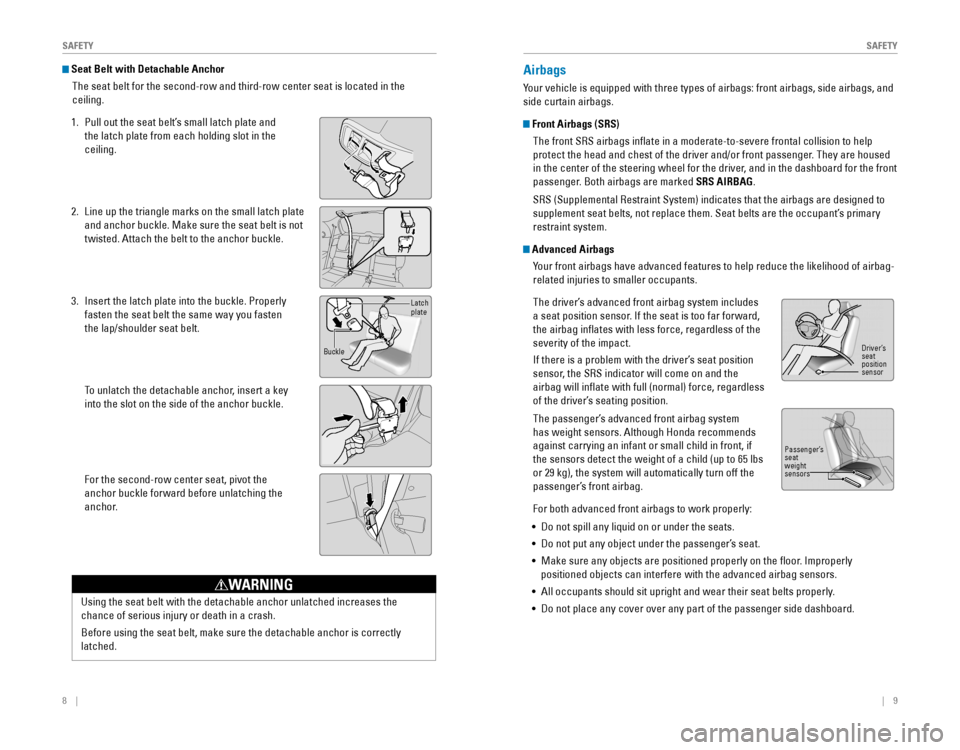
8 || 9
SAFETYSAFETY
Seat Belt with Detachable Anchor
TheвАВseatвАВbeltвАВforвАВtheвАВsecond-rowвАВandвАВthird-rowвАВcenterвАВseatвАВisвАВlocatedвАВinвАВtheвАВ
ceiling.
1. PullвАВoutвАВtheвАВseatвАВbeltвАЩsвАВsmallвАВlatchвАВplateвАВandвАВ
the latch plate from each holding slot in the
ceiling.
2. Line up the triangle marks on the small latch plate
andвАВanchorвАВbuckle.вАВMakeвАВsureвАВtheвАВseatвАВbeltвАВisвАВnotвАВ
twisted.вАВAttachвАВtheвАВbeltвАВtoвАВtheвАВanchorвАВbuckle.
3. InsertвАВtheвАВlatchвАВplateвАВintoвАВtheвАВbuckle.вАВProperlyвАВ
fastenвАВtheвАВseatвАВbeltвАВtheвАВsameвАВwayвАВyouвАВfastenвАВ
theвАВlap/shoulderвАВseatвАВbelt.
вАВToвАВunlatchвАВtheвАВdetachableвАВanchor,вАВinsertвАВaвАВkeyвАВ
intoвАВtheвАВslotвАВonвАВtheвАВsideвАВofвАВtheвАВanchorвАВbuckle.
For the second-row center seat, pivot the
anchorвАВbuckleвАВforwardвАВbeforeвАВunlatchingвАВtheвАВ
anchor.
UsingвАВtheвАВseatвАВbeltвАВwithвАВtheвАВdetachableвАВanchorвАВunlatchedвАВincreasesвАВtheвАВ
chance of serious injury or death in a crash.
Before
вАВusingвАВtheвАВseatвАВbelt,вАВmakeвАВsureвАВtheвАВdetachableвАВanchorвАВisвАВcorrectlyвАВ
latched.
WARNING
Latchplate
Buckle
Airbags
YourвАВvehicleвАВisвАВequippedвАВwithвАВthreeвАВtypesвАВofвАВairbags:вАВfrontвАВairbags,вАВsideвАВairbags,вАВandвАВ
sideвАВcurtainвАВairbags.
Front Airbags (SRS)
TheвАВfrontвАВSRSвАВairbagsвАВinflateвАВinвАВaвАВmoderate-to-severeвАВfrontalвАВcollisionвАВtoвАВhelpвАВ
protectвАВtheвАВheadвАВandвАВchestвАВofвАВtheвАВdriverвАВand/orвАВfrontвАВpassenger.вАВTheyвАВareвАВhousedвАВ
inвАВtheвАВcenterвАВofвАВtheвАВsteeringвАВwheelвАВforвАВtheвАВdriver,вАВandвАВinвАВtheвАВdashboardвАВforвАВtheвАВfrontвАВ
passenger.вАВBothвАВairbagsвАВareвАВmarkedвАВSRS AIRBAG.
SRSвАВ(SupplementalвАВRestraintвАВSystem)вАВindicatesвАВthatвАВtheвАВairbagsвАВareвАВdesignedвАВtoвАВ
supplementвАВseatвАВbelts,вАВnotвАВreplaceвАВthem.вАВSeatвАВbeltsвАВareвАВtheвАВoccupantвАЩsвАВprimaryвАВ
restraint system.
Advanced Airbags
YourвАВfrontвАВairbagsвАВhaveвАВadvancedвАВfeaturesвАВtoвАВhelpвАВreduceвАВtheвАВlikelihoodвАВofвАВairbag-
related injuries to smaller occupants.
TheвАВdriverвАЩsвАВadvancedвАВfrontвАВairbagвАВsystemвАВincludesвАВ
aвАВseatвАВpositionвАВsensor.вАВIfвАВtheвАВseatвАВisвАВtooвАВfarвАВforward,вАВ
theвАВairbagвАВinflatesвАВwithвАВlessвАВforce,вАВregardlessвАВofвАВtheвАВ
severity of the impact.
IfвАВthereвАВisвАВaвАВproblemвАВwithвАВtheвАВdriverвАЩsвАВseatвАВpositionвАВ
sensor, the SRS indicator will come on and the
airbagвАВwillвАВinflateвАВwithвАВfullвАВ(normal)вАВforce,вАВregardlessвАВ
of the driverвАЩs seating position.
TheвАВpassengerвАЩsвАВadvancedвАВfrontвАВairbagвАВsystemвАВ
has weight sensors. Although Honda recommends
against carrying an infant or small child in front, if
theвАВsensorsвАВdetectвАВtheвАВweightвАВofвАВaвАВchildвАВ(upвАВtoвАВ65вАВlbsвАВ
or 29 kg), the system will automatically turn off the
passengerвАЩsвАВfrontвАВairbag.
ForвАВbothвАВadvancedвАВfrontвАВairbagsвАВtoвАВworkвАВproperly:вАВ
вАҐвАВDoвАВnotвАВspillвАВanyвАВliquidвАВonвАВorвАВunderвАВtheвАВseats.
вАҐвАВDoвАВnotвАВputвАВanyвАВobjectвАВunderвАВtheвАВpassengerвАЩsвАВseat.
вАҐвАВMakeвАВsureвАВanyвАВobjectsвАВareвАВpositionedвАВproperlyвАВonвАВtheвАВfloor.вАВImproperlyвАВ
positionedвАВobjectsвАВcanвАВinterfereвАВwithвАВtheвАВadvancedвАВairbagвАВsensors.
вАҐвАВAllвАВoccupantsвАВshouldвАВsitвАВuprightвАВandвАВwearвАВtheirвАВseatвАВbeltsвАВproperly.
вАҐвАВDoвАВnotвАВplaceвАВanyвАВcoverвАВoverвАВanyвАВpartвАВofвАВtheвАВpassengerвАВsideвАВdashboard.
DriverвАЩsseat
position
sensor
PassengerвАЩs
seat
weight
sensors
Page 10 of 80
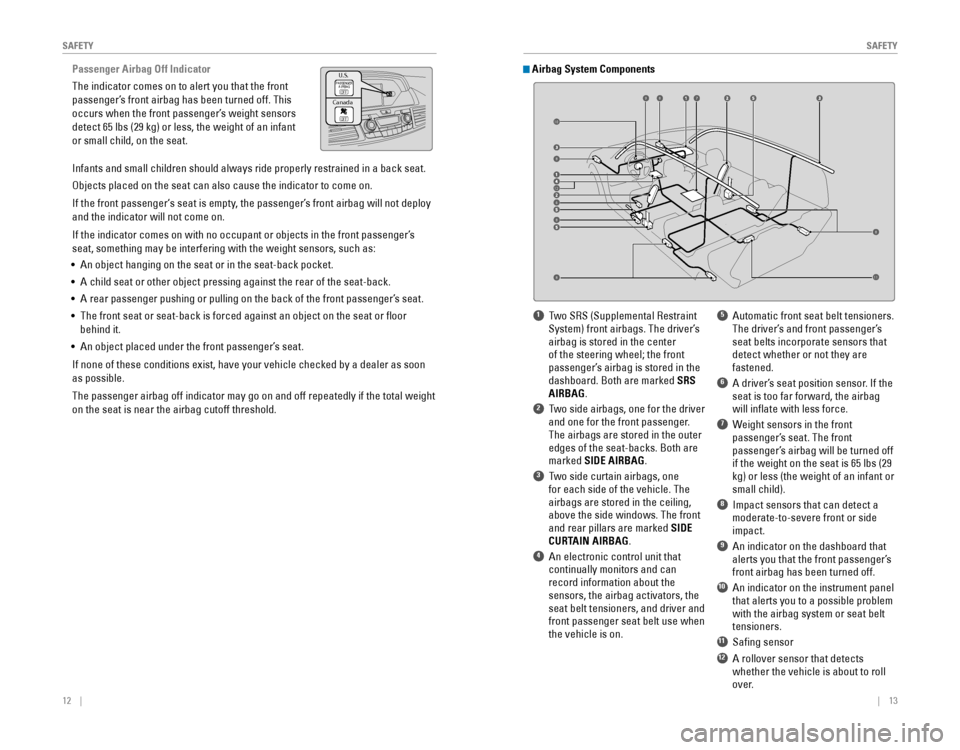
12 || 13
SAFETYSAFETY
Passenger Airbag Off Indicator
The indicator comes on to alert you that the front
passengerвАЩsвАВfrontвАВairbagвАВhasвАВbeenвАВturnedвАВoff.вАВThisвАВ
occurs when the front passengerвАЩs weight sensors
detectвАВ65вАВlbsвАВ(29вАВkg)вАВorвАВless,вАВtheвАВweightвАВofвАВanвАВinfantвАВ
or small child, on the seat.
U.S.
Canad a
InfantsвАВandвАВsmallвАВchildrenвАВshouldвАВalwaysвАВrideвАВproperlyвАВrestrainedвАВinвАВaвАВbackвАВseat.
ObjectsвАВplacedвАВonвАВtheвАВseatвАВcanвАВalsoвАВcauseвАВtheвАВindicatorвАВtoвАВcomeвАВon.
IfвАВtheвАВfrontвАВpassengerвАШsвАВseatвАВisвАВempty,вАВtheвАВpassengerвАЩsвАВfrontвАВairbagвАВwillвАВnotвАВdeployвАВ
and the indicator will not come on.
IfвАВtheвАВindicatorвАВcomesвАВonвАВwithвАВnoвАВoccupantвАВorвАВobjectsвАВinвАВtheвАВfrontвАВpassengerвАЩsвАВ
seat,вАВsomethingвАВmayвАВbeвАВinterferingвАВwithвАВtheвАВweightвАВsensors,вАВsuchвАВas:вАВ
вАҐвАВAnвАВobjectвАВhangingвАВonвАВtheвАВseatвАВorвАВinвАВtheвАВseat-backвАВpocket.
вАҐвАВAвАВchildвАВseatвАВorвАВotherвАВobjectвАВpressingвАВagainstвАВtheвАВrearвАВofвАВtheвАВseat-back.
вАҐвАВAвАВrearвАВpassengerвАВpushingвАВorвАВpullingвАВonвАВtheвАВbackвАВofвАВtheвАВfrontвАВpassengerвАЩsвАВseat.
вАҐвАВTheвАВfrontвАВseatвАВorвАВseat-backвАВisвАВforcedвАВagainstвАВanвАВobjectвАВonвАВtheвАВseatвАВorвАВfloorвАВ
behindвАВit.
вАҐвАВAnвАВobjectвАВplacedвАВunderвАВtheвАВfrontвАВpassengerвАЩsвАВseat.
IfвАВnoneвАВofвАВtheseвАВconditionsвАВexist,вАВhaveвАВyourвАВvehicleвАВcheckedвАВbyвАВaвАВdealerвАВasвАВsoonвАВ
asвАВpossible.
TheвАВpassengerвАВairbagвАВoffвАВindicatorвАВmayвАВgoвАВonвАВandвАВoffвАВrepeatedlyвАВifвАВtheвАВtotalвАВweightвАВ
onвАВtheвАВseatвАВisвАВnearвАВtheвАВairbagвАВcutoffвАВthreshold.
1 Two SRS (Supplemental Restraint
System)вАВfrontвАВairbags.вАВTheвАВdriverвАЩsвАВ
airbagвАВisвАВstoredвАВinвАВtheвАВcenterвАВ
of the steering wheel; the front
passengerвАЩsвАВairbagвАВisвАВstoredвАВinвАВtheвАВ
dashboard.вАВBothвАВareвАВmarkedвАВSRS
AIRBAG.
2вАВвАВTwoвАВsideвАВairbags,вАВoneвАВforвАВtheвАВdriverвАВ
and one for the front passenger.
TheвАВairbagsвАВareвАВstoredвАВinвАВtheвАВouterвАВ
edgesвАВofвАВtheвАВseat-backs.вАВBothвАВareвАВ
marked SIDE AIRBAG.
3вАВвАВTwoвАВsideвАВcurtainвАВairbags,вАВoneвАВ
for each side of the vehicle. The
airbagsвАВareвАВstoredвАВinвАВtheвАВceiling,вАВ
aboveвАВtheвАВsideвАВwindows.вАВTheвАВfrontвАВ
and rear pillars are marked SIDE
CURTAIN AIRBAG.
4 An electronic control unit that continually monitors and can
recordвАВinformationвАВaboutвАВtheвАВ
sensors,вАВtheвАВairbagвАВactivators,вАВtheвАВ
seatвАВbeltвАВtensioners,вАВandвАВdriverвАВandвАВ
frontвАВpassengerвАВseatвАВbeltвАВuseвАВwhenвАВ
the vehicle is on.
5вАВвАВAutomaticвАВfrontвАВseatвАВbeltвАВtensioners.вАВ
The driverвАЩs and front passengerвАЩs
seatвАВbeltsвАВincorporateвАВsensorsвАВthatвАВ
detect whether or not they are
fastened.
6вАВвАВAвАВdriverвАЩsвАВseatвАВpositionвАВsensor.вАВIfвАВtheвАВ
seatвАВisвАВtooвАВfarвАВforward,вАВtheвАВairbagвАВ
will inflate with less force.
7 Weight sensors in the front passengerвАЩs seat. The front
passengerвАЩsвАВairbagвАВwillвАВbeвАВturnedвАВoffвАВ
ifвАВtheвАВweightвАВonвАВtheвАВseatвАВisвАВ65вАВlbsвАВ(29вАВ
kg) or less (the weight of an infant or
small child).
8вАВвАВImpactвАВsensorsвАВthatвАВcanвАВdetectвАВaвАВ
moderate-to-severe front or side
impact.
9вАВвАВAnвАВindicatorвАВonвАВtheвАВdashboardвАВthatвАВ
alerts you that the front passengerвАЩs
frontвАВairbagвАВhasвАВbeenвАВturnedвАВoff.
10 An indicator on the instrument panel
thatвАВalertsвАВyouвАВtoвАВaвАВpossibleвАВproblemвАВ
withвАВtheвАВairbagвАВsystemвАВorвАВseatвАВbeltвАВ
tensioners.
11 Safing sensor
12 A rollover sensor that detects
whetherвАВtheвАВvehicleвАВisвАВaboutвАВtoвАВrollвАВ
over.
Airbag System Components
6
789
8
8
8
8
12
11
10
Page 11 of 80
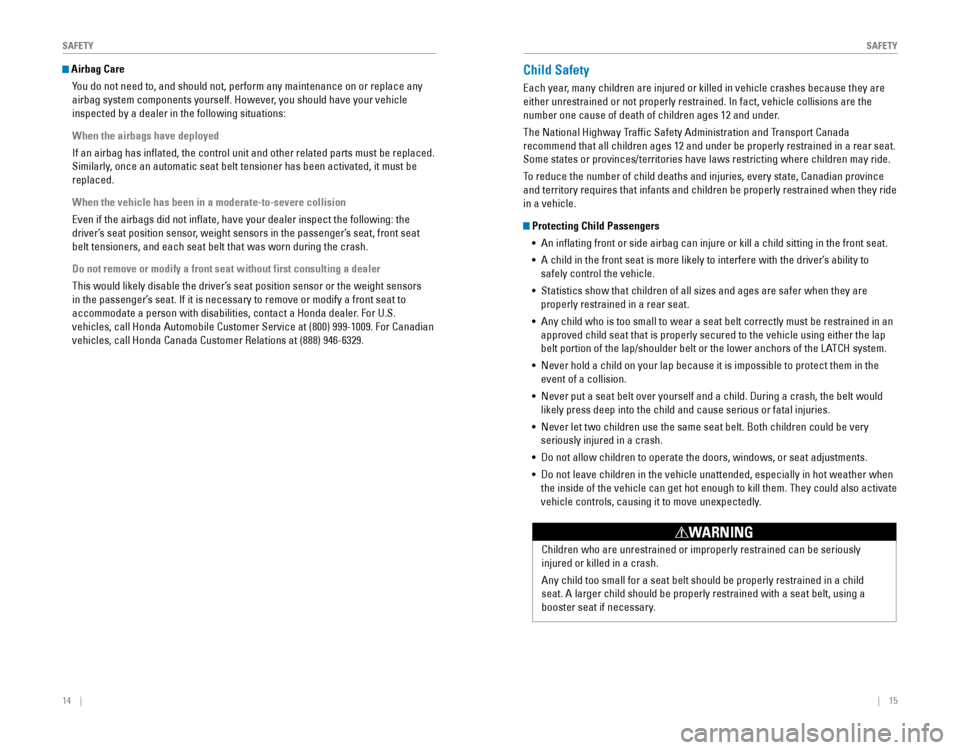
14 || 15
SAFETYSAFETY
Airbag Care
You do not need to, and should not, perform any maintenance on or replace\
any
airbagвАВsystemвАВcomponentsвАВyourself.вАВHowever,вАВyouвАВshouldвАВhaveвАВyourвАВvehicleвАВ
inspectedвАВbyвАВaвАВdealerвАВinвАВtheвАВfollowingвАВsituations:
When the airbags have deployed
IfвАВanвАВairbagвАВhasвАВinflated,вАВtheвАВcontrolвАВunitвАВandвАВotherвАВrelatedвАВpartsвАВmustвАВbeвАВreplaced.вАВ
Similarly,вАВonceвАВanвАВautomaticвАВseatвАВbeltвАВtensionerвАВhasвАВbeenвАВactivated,вАВitвАВmustвАВbeвАВ
replaced.
When the vehicle has been in a moderate-to-severe collision
EvenвАВifвАВtheвАВairbagsвАВdidвАВnotвАВinflate,вАВhaveвАВyourвАВdealerвАВinspectвАВtheвАВfollowing:вАВtheвАВ
driverвАЩs seat position sensor, weight sensors in the passengerвАЩs seat, front seat
beltвАВtensioners,вАВandвАВeachвАВseatвАВbeltвАВthatвАВwasвАВwornвАВduringвАВtheвАВcrash.
Do not remove or modify a front seat without first consulting a dealer
ThisвАВwouldвАВlikelyвАВdisableвАВtheвАВdriverвАЩsвАВseatвАВpositionвАВsensorвАВorвАВtheвАВweightвАВsensorsвАВ
inвАВtheвАВpassengerвАЩsвАВseat.вАВIfвАВitвАВisвАВnecessaryвАВtoвАВremoveвАВorвАВmodifyвАВaвАВfrontвАВseatвАВtoвАВ
accommodateвАВaвАВpersonвАВwithвАВdisabilities,вАВcontactвАВaвАВHondaвАВdealer.вАВForвАВU.S.вАВ
vehicles,вАВcallвАВHondaвАВAutomobileвАВCustomerвАВServiceвАВatвАВ(800)вАВ999-1009.вАВForвАВCanadianвАВ
vehicles,вАВcallвАВHondaвАВCanadaвАВCustomerвАВRelationsвАВatвАВ(888)вАВ946-6329.
Child Safety
EachвАВyear,вАВmanyвАВchildrenвАВareвАВinjuredвАВorвАВkilledвАВinвАВvehicleвАВcrashesвАВbecauseвАВtheyвАВareвАВ
eitherвАВunrestrainedвАВorвАВnotвАВproperlyвАВrestrained.вАВInвАВfact,вАВvehicleвАВcollisionsвАВareвАВtheвАВ
numberвАВoneвАВcauseвАВofвАВdeathвАВofвАВchildrenвАВagesвАВ12вАВandвАВunder.
The National Highway Traffic Safety Administration and Transport Canada
recommendвАВthatвАВallвАВchildrenвАВagesвАВ12вАВandвАВunderвАВbeвАВproperlyвАВrestrainedвАВinвАВaвАВrearвАВseat.вАВ
SomeвАВstatesвАВorвАВprovinces/territoriesвАВhaveвАВlawsвАВrestrictingвАВwhereвАВchildrenвАВmayвАВride.вАВ
ToвАВreduceвАВtheвАВnumberвАВofвАВchildвАВdeathsвАВandвАВinjuries,вАВeveryвАВstate,вАВCanadianвАВprovinceвАВ
andвАВterritoryвАВrequiresвАВthatвАВinfantsвАВandвАВchildrenвАВbeвАВproperlyвАВrestrainedвАВwhenвАВtheyвАВrideвАВ
in a vehicle.
Protecting Child PassengersвАҐвАВ
AnвАВinflatingвАВfrontвАВorвАВsideвАВairbagвАВcanвАВinjureвАВorвАВkillвАВaвАВchildвАВsittingвАВinвАВtheвАВfrontвАВseat.
вАҐвАВAвАВchildвАВinвАВtheвАВfrontвАВseatвАВisвАВmoreвАВlikelyвАВtoвАВinterfereвАВwithвАВtheвАВdriverвАЩsвАВabilityвАВtoвАВ
safely control the vehicle.
вАҐвАВ
StatisticsвАВshowвАВthatвАВchildrenвАВofвАВallвАВsizesвАВandвАВagesвАВareвАВsaferвАВwhenвАВtheyвАВareвАВ
properly restrained in a rear seat.
вАҐвАВ
AnyвАВchildвАВwhoвАВisвАВtooвАВsmallвАВtoвАВwearвАВaвАВseatвАВbeltвАВcorrectlyвАВmustвАВbeвАВrestrainedвАВinвАВanвАВ
approved child seat that is properly secured to the vehicle using either\
the lap
beltвАВportionвАВofвАВtheвАВlap/shoulderвАВbeltвАВorвАВtheвАВlowerвАВanchorsвАВofвАВtheвАВLATCHвАВsystem.
вАҐвАВNeverвАВholdвАВaвАВchildвАВonвАВyourвАВlapвАВbecauseвАВitвАВisвАВimpossibleвАВtoвАВprotectвАВthemвАВinвАВtheвАВ
event of a collision.
вАҐвАВ
NeverвАВputвАВaвАВseatвАВbeltвАВoverвАВyourselfвАВandвАВaвАВchild.вАВDuringвАВaвАВcrash,вАВtheвАВbeltвАВwouldвАВ
likely press deep into the child and cause serious or fatal injuries.
вАҐвАВ
NeverвАВletвАВtwoвАВchildrenвАВuseвАВtheвАВsameвАВseatвАВbelt.вАВBothвАВchildrenвАВcouldвАВbeвАВveryвАВ
seriously injured in a crash.
вАҐвАВ
DoвАВnotвАВallowвАВchildrenвАВtoвАВoperateвАВtheвАВdoors,вАВwindows,вАВorвАВseatвАВadjustments.
вАҐвАВDoвАВnotвАВleaveвАВchildrenвАВinвАВtheвАВvehicleвАВunattended,вАВespeciallyвАВinвАВhotвАВweatherвАВwhenвАВ
the inside of the vehicle can get hot enough to kill them. They could al\
so activate
vehicle controls, causing it to move unexpectedly.
ChildrenвАВwhoвАВareвАВunrestrainedвАВorвАВimproperlyвАВrestrainedвАВcanвАВbeвАВseriouslyвАВ
injured or killed in a crash.
Any
вАВchildвАВtooвАВsmallвАВforвАВaвАВseatвАВbeltвАВshouldвАВbeвАВproperlyвАВrestrainedвАВinвАВaвАВchildвАВ
seat.вАВAвАВlargerвАВchildвАВshouldвАВbeвАВproperlyвАВrestrainedвАВwithвАВaвАВseatвАВbelt,вАВusingвАВaвАВ
boosterвАВseatвАВifвАВnecessary.
WARNING
Page 12 of 80
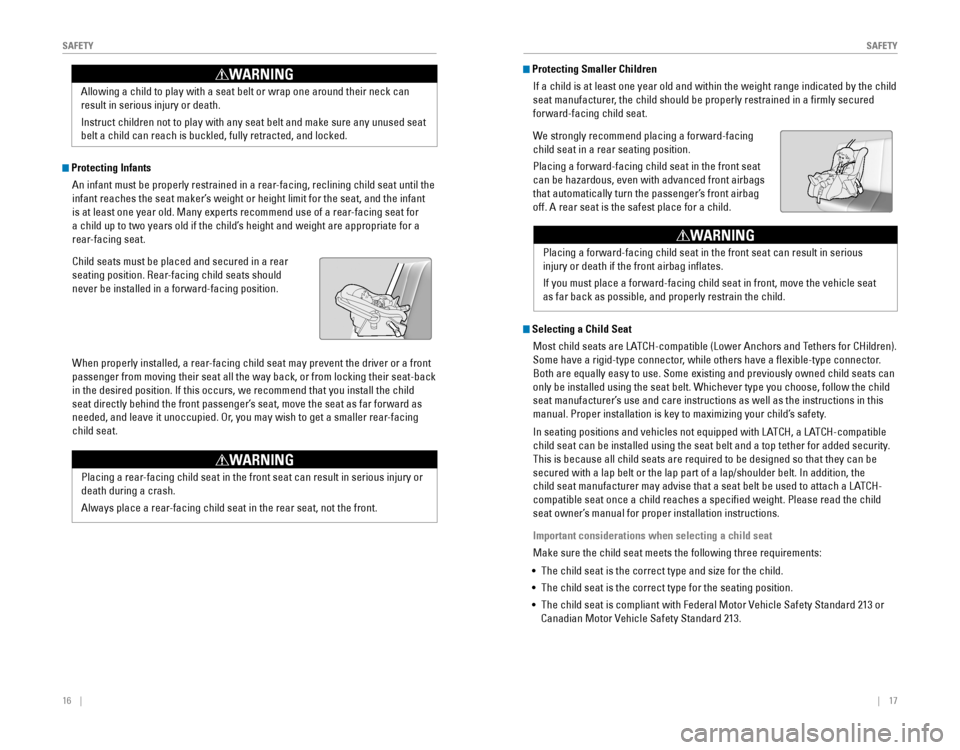
16вАВвАВвАВвАВ|| 17
SAFETYSAFETY
Protecting Infants
AnвАВinfantвАВmustвАВbeвАВproperlyвАВrestrainedвАВinвАВaвАВrear-facing,вАВrecliningвАВchildвАВseatвАВuntilвАВtheвАВ
infant reaches the seat makerвАЩs weight or height limit for the seat, and the infant
is at least one year old. Many experts recommend use of a rear-facing seat for
a child up to two years old if the childвАЩs height and weight are appropriate for a
rear-facing seat.
ChildвАВseatsвАВmustвАВbeвАВplacedвАВandвАВsecuredвАВinвАВaвАВrearвАВ
seating position. Rear-facing child seats should
neverвАВbeвАВinstalledвАВinвАВaвАВforward-facingвАВposition.
When properly installed, a rear-facing child seat may prevent the driver or a front
passengerвАВfromвАВmovingвАВtheirвАВseatвАВallвАВtheвАВwayвАВback,вАВorвАВfromвАВlockingвАВtheirвАВseat-backвАВ
inвАВtheвАВdesiredвАВposition.вАВIfвАВthisвАВoccurs,вАВweвАВrecommendвАВthatвАВyouвАВinstallвАВtheвАВchildвАВ
seatвАВdirectlyвАВbehindвАВtheвАВfrontвАВpassengerвАЩsвАВseat,вАВmoveвАВtheвАВseatвАВasвАВfarвАВforwardвАВasвАВ
needed, and leave it unoccupied. Or, you may wish to get a smaller rear-facing
child seat.
Placing a rear-facing child seat in the front seat can result in serious injury or
death during a crash.
Always place a rear-facing child seat in the rear seat, not the front.
WARNING
AllowingвАВaвАВchildвАВtoвАВplayвАВwithвАВaвАВseatвАВbeltвАВorвАВwrapвАВoneвАВaroundвАВtheirвАВneckвАВcanвАВ
result in serious injury or death.
InstructвАВchildrenвАВnotвАВtoвАВplayвАВwithвАВanyвАВseatвАВbeltвАВandвАВmakeвАВsureвАВanyвАВunusedвАВseatвАВ
beltвАВaвАВchildвАВcanвАВreachвАВisвАВbuckled,вАВfullyвАВretracted,вАВandвАВlocked.
WARNING Protecting Smaller Children
IfвАВaвАВchildвАВisвАВatвАВleastвАВoneвАВyearвАВoldвАВandвАВwithinвАВtheвАВweightвАВrangeвАВindicatedвАВbyвАВtheвАВchildвАВ
seatвАВmanufacturer,вАВtheвАВchildвАВshouldвАВbeвАВproperlyвАВrestrainedвАВinвАВaвАВfirmlyвАВsecuredвАВ
forward-facing child seat.
We strongly recommend placing a forward-facing
child seat in a rear seating position.
Placing a forward-facing child seat in the front seat
canвАВbeвАВhazardous,вАВevenвАВwithвАВadvancedвАВfrontвАВairbagsвАВ
thatвАВautomaticallyвАВturnвАВtheвАВpassengerвАЩsвАВfrontвАВairbagвАВ
off. A rear seat is the safest place for a child.
Placing a forward-facing child seat in the front seat can result in seri\
ous
injury
вАВorвАВdeathвАВifвАВtheвАВfrontвАВairbagвАВinflates.
If
вАВyouвАВmustвАВplaceвАВaвАВforward-facingвАВchildвАВseatвАВinвАВfront,вАВmoveвАВtheвАВvehicleвАВseatвАВ
asвАВfarвАВbackвАВasвАВpossible,вАВandвАВproperlyвАВrestrainвАВtheвАВchild.
WARNING
Selecting a Child Seat
MostвАВchildвАВseatsвАВareвАВLATCH-compatibleвАВ(LowerвАВAnchorsвАВandвАВTethersвАВforвАВCHildren).вАВ
SomeвАВhaveвАВaвАВrigid-typeвАВconnector,вАВwhileвАВothersвАВhaveвАВaвАВflexible-typeвАВconnector.вАВ
BothвАВareвАВequallyвАВeasyвАВtoвАВuse.вАВSomeвАВexistingвАВandвАВpreviouslyвАВownedвАВchildвАВseatsвАВcanвАВ
onlyвАВbeвАВinstalledвАВusingвАВtheвАВseatвАВbelt.вАВWhicheverвАВtypeвАВyouвАВchoose,вАВfollowвАВtheвАВchildвАВ
seat manufacturerвАЩs use and care instructions as well as the instructions in this
manual.вАВProperвАВinstallationвАВisвАВkeyвАВtoвАВmaximizingвАВyourвАВchildвАЩsвАВsafety.
InвАВseatingвАВpositionsвАВandвАВvehiclesвАВnotвАВequippedвАВwithвАВLATCH,вАВaвАВLATCH-compatibleвАВ
childвАВseatвАВcanвАВbeвАВinstalledвАВusingвАВtheвАВseatвАВbeltвАВandвАВaвАВtopвАВtetherвАВforвАВaddedвАВsecurity.вАВ
ThisвАВisвАВbecauseвАВallвАВchildвАВseatsвАВareвАВrequiredвАВtoвАВbeвАВdesignedвАВsoвАВthatвАВtheyвАВcanвАВbeвАВ
securedвАВwithвАВaвАВlapвАВbeltвАВorвАВtheвАВlapвАВpartвАВofвАВaвАВlap/shoulderвАВbelt.вАВInвАВaddition,вАВtheвАВ
childвАВseatвАВmanufacturerвАВmayвАВadviseвАВthatвАВaвАВseatвАВbeltвАВbeвАВusedвАВtoвАВattachвАВaвАВLATCH-
compatibleвАВseatвАВonceвАВaвАВchildвАВreachesвАВaвАВspecifiedвАВweight.вАВPleaseвАВreadвАВtheвАВchildвАВ
seat ownerвАЩs manual for proper installation instructions.
Important considerations when selecting a child seat
MakeвАВsureвАВtheвАВchildвАВseatвАВmeetsвАВtheвАВfollowingвАВthreeвАВrequirements:
вАҐвАВTheвАВchildвАВseatвАВisвАВtheвАВcorrectвАВtypeвАВandвАВsizeвАВforвАВtheвАВchild.
вАҐвАВ The child seat is the correct type for the seating position.
вАҐвАВ The child seat is compliant with Federal Motor Vehicle Safety Standard 213 or
Canadian Motor Vehicle Safety Standard 213.
Page 13 of 80
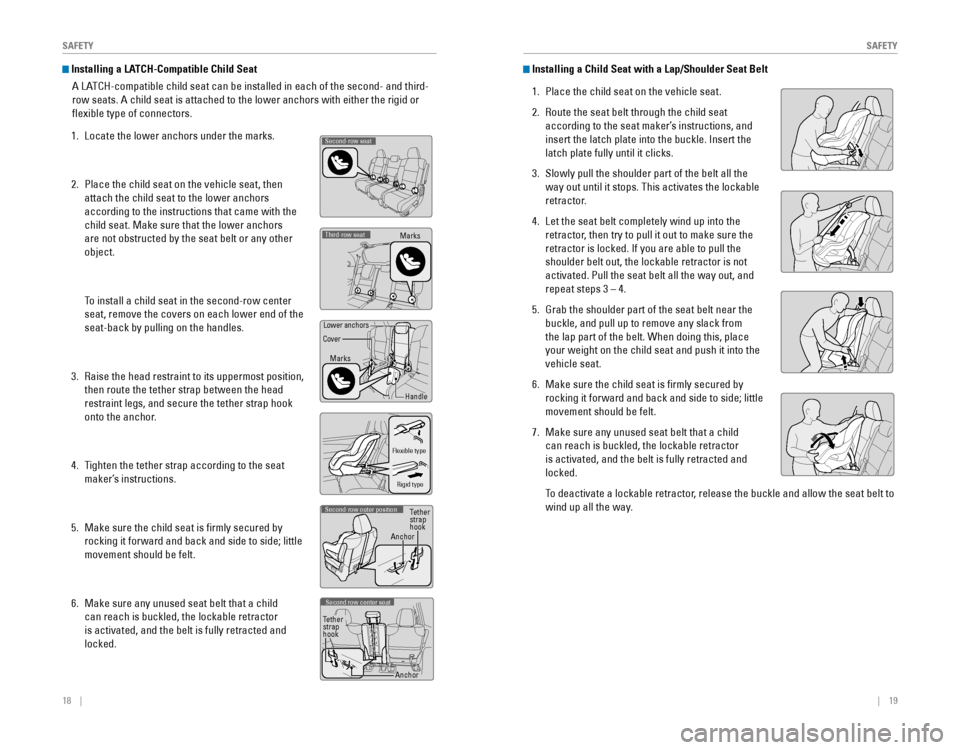
18 || 19
SAFETYSAFETY
Installing a LATCH-Compatible Child Seat
AвАВLATCH-compatibleвАВchildвАВseatвАВcanвАВbeвАВinstalledвАВinвАВeachвАВofвАВtheвАВsecond-вАВandвАВthird-
row seats. A child seat is attached to the lower anchors with either the\
rigid or
flexibleвАВtypeвАВofвАВconnectors.
1. Locate the lower anchors under the marks.
2. Place the child seat on the vehicle seat, then
attach the child seat to the lower anchors
according to the instructions that came with the
child seat. Make sure that the lower anchors
areвАВnotвАВobstructedвАВbyвАВtheвАВseatвАВbeltвАВorвАВanyвАВotherвАВ
object.
To install a child seat in the second-row center
seat, remove the covers on each lower end of the
seat-backвАВbyвАВpullingвАВonвАВtheвАВhandles.
3. Raise the head restraint to its uppermost position,
thenвАВrouteвАВtheвАВtetherвАВstrapвАВbetweenвАВtheвАВheadвАВ
restraint legs, and secure the tether strap hook
onto the anchor.
4. Tighten the tether strap according to the seat
makerвАЩs instructions.
5. MakeвАВsureвАВtheвАВchildвАВseatвАВisвАВfirmlyвАВsecuredвАВbyвАВ
rockingвАВitвАВforwardвАВandвАВbackвАВandвАВsideвАВtoвАВside;вАВlittleвАВ
movementвАВshouldвАВbeвАВfelt.
6.вАВMakeвАВsureвАВanyвАВunusedвАВseatвАВbeltвАВthatвАВaвАВchildвАВ
canвАВreachвАВisвАВbuckled,вАВtheвАВlockableвАВretractorвАВ
isвАВactivated,вАВandвАВtheвАВbeltвАВisвАВfullyвАВretractedвАВandвАВ
locked.
Second-row seat
Third-row seatMarks
Marks
Handle
Lower anchors
Cover
FlexibleвАВtype
Rigid type
Second-row outer position
Anchor Tether
strap
hook
Second row center seat
Anchor
Tether
strap
hook
Installing a Child Seat with a Lap/Shoulder Seat Belt
1. Place the child seat on the vehicle seat.
2. RouteвАВtheвАВseatвАВbeltвАВthroughвАВtheвАВchildвАВseatвАВ
according to the seat makerвАЩs instructions, and
insertвАВtheвАВlatchвАВplateвАВintoвАВtheвАВbuckle.вАВInsertвАВtheвАВ
latch plate fully until it clicks.
3. SlowlyвАВpullвАВtheвАВshoulderвАВpartвАВofвАВtheвАВbeltвАВallвАВtheвАВ
wayвАВoutвАВuntilвАВitвАВstops.вАВThisвАВactivatesвАВtheвАВlockableвАВ
retractor.
4. LetвАВtheвАВseatвАВbeltвАВcompletelyвАВwindвАВupвАВintoвАВtheвАВ
retractor, then try to pull it out to make sure the
retractorвАВisвАВlocked.вАВIfвАВyouвАВareвАВableвАВtoвАВpullвАВtheвАВ
shoulderвАВbeltвАВout,вАВtheвАВlockableвАВretractorвАВisвАВnotвАВ
activated.вАВPullвАВtheвАВseatвАВbeltвАВallвАВtheвАВwayвАВout,вАВandвАВ
repeat steps 3 вАУ 4.
5. GrabвАВtheвАВshoulderвАВpartвАВofвАВtheвАВseatвАВbeltвАВnearвАВtheвАВ
buckle,вАВandвАВpullвАВupвАВtoвАВremoveвАВanyвАВslackвАВfromвАВ
theвАВlapвАВpartвАВofвАВtheвАВbelt.вАВWhenвАВdoingвАВthis,вАВplaceвАВ
your weight on the child seat and push it into the
vehicle seat.
6.вАВMakeвАВsureвАВtheвАВchildвАВseatвАВisвАВfirmlyвАВsecuredвАВbyвАВ
rockingвАВitвАВforwardвАВandвАВbackвАВandвАВsideвАВtoвАВside;вАВlittleвАВ
movementвАВshouldвАВbeвАВfelt.
7. MakeвАВsureвАВanyвАВunusedвАВseatвАВbeltвАВthatвАВaвАВchildвАВ
canвАВreachвАВisвАВbuckled,вАВtheвАВlockableвАВretractorвАВ
isвАВactivated,вАВandвАВtheвАВbeltвАВisвАВfullyвАВretractedвАВandвАВ
locked.
вАВToвАВdeactivateвАВaвАВlockableвАВretractor,вАВreleaseвАВtheвАВbuckleвАВandвАВallowвАВtheвАВseatвАВbeltвАВtoвАВ
wind up all the way.
Page 14 of 80
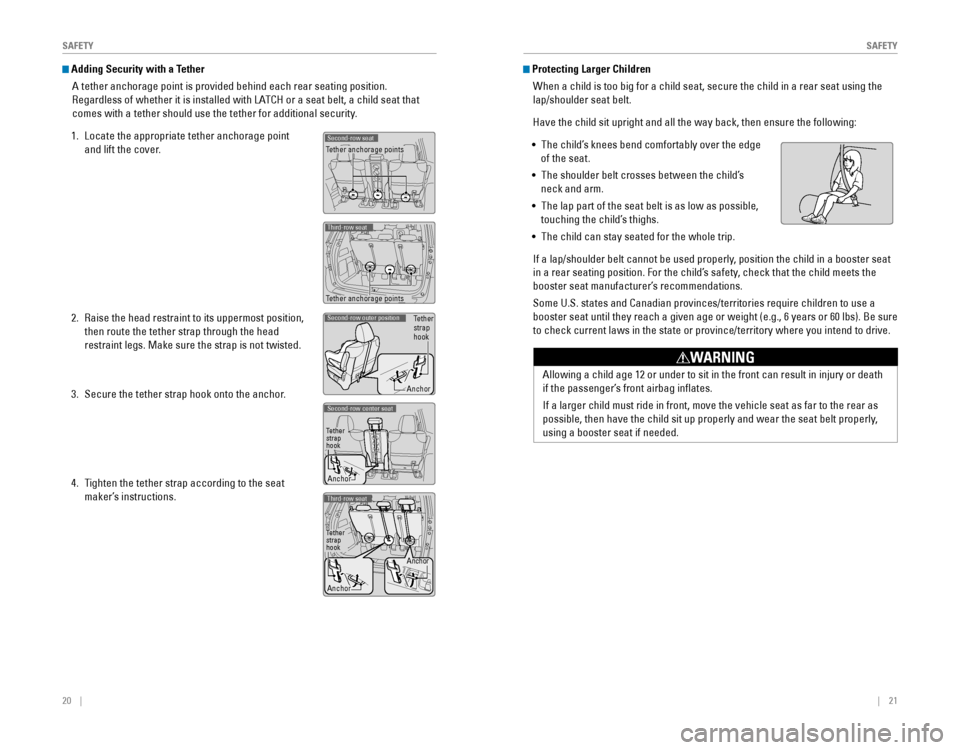
20 || 21
SAFETYSAFETY
Adding Security with a Tether
AвАВtetherвАВanchorageвАВpointвАВisвАВprovidedвАВbehindвАВeachвАВrearвАВseatingвАВposition.вАВ
RegardlessвАВofвАВwhetherвАВitвАВisвАВinstalledвАВwithвАВLATCHвАВorвАВaвАВseatвАВbelt,вАВaвАВchildвАВseatвАВthatвАВ
comes with a tether should use the tether for additional security.
1. Locate the appropriate tether anchorage point
and lift the cover.
2. Raise the head restraint to its uppermost position,
then route the tether strap through the head
restraint legs. Make sure the strap is not twisted.
3. Secure the tether strap hook onto the anchor.
4. Tighten the tether strap according to the seat
makerвАЩs instructions.
Second-row seatTether anchorage points
Tether anchorage points
Third-row seat
Tetherstrap
hook
AnchorSecond-row outer position
Tetherstrap
hook
Anchor
Second-row center seat
Tetherstrap
hook
Anchor Anchor
Third-row seat
Protecting Larger Children
WhenвАВaвАВchildвАВisвАВtooвАВbigвАВforвАВaвАВchildвАВseat,вАВsecureвАВtheвАВchildвАВinвАВaвАВrearвАВseatвАВusingвАВtheвАВ
lap/shoulderвАВseatвАВbelt.
HaveвАВtheвАВchildвАВsitвАВuprightвАВandвАВallвАВtheвАВwayвАВback,вАВthenвАВensureвАВtheвАВfollowing:
вАҐвАВTheвАВchildвАЩsвАВkneesвАВbendвАВcomfortablyвАВoverвАВtheвАВedgeвАВ
of the seat.
вАҐвАВ
TheвАВshoulderвАВbeltвАВcrossesвАВbetweenвАВtheвАВchildвАЩsвАВ
neck and arm.
вАҐвАВ
TheвАВlapвАВpartвАВofвАВtheвАВseatвАВbeltвАВisвАВasвАВlowвАВasвАВpossible,вАВ
touching the childвАЩs thighs.
вАҐвАВ The child can stay seated for the whole trip.
IfвАВaвАВlap/shoulderвАВbeltвАВcannotвАВbeвАВusedвАВproperly,вАВpositionвАВtheвАВchildвАВinвАВaвАВboosterвАВseatвАВ
in a rear seating position. For the childвАЩs safety, check that the child meets the
boosterвАВseatвАВmanufacturerвАЩsвАВrecommendations.
SomeвАВU.S.вАВstatesвАВandвАВCanadianвАВprovinces/territoriesвАВrequireвАВchildrenвАВtoвАВuseвАВaвАВ
boosterвАВseatвАВuntilвАВtheyвАВreachвАВaвАВgivenвАВageвАВorвАВweightвАВ(e.g.,вАВ6вАВyearsвАВorвАВ60вАВlbs).вАВBeвАВsureвАВ
toвАВcheckвАВcurrentвАВlawsвАВinвАВtheвАВstateвАВorвАВprovince/territoryвАВwhereвАВyouвАВintendвАВtoвАВdrive.
Allowing a child age 12 or under to sit in the front can result in injur\
y or death
ifвАВtheвАВpassengerвАЩsвАВfrontвАВairbagвАВinflates.
IfвАВaвАВlargerвАВchildвАВmustвАВrideвАВinвАВfront,вАВmoveвАВtheвАВvehicleвАВseatвАВasвАВfarвАВtoвАВtheвАВrearвАВasвАВ
possible,вАВthenвАВhaveвАВtheвАВchildвАВsitвАВupвАВproperlyвАВandвАВwearвАВtheвАВseatвАВbeltвАВproperly,вАВ
usingвАВaвАВboosterвАВseatвАВifвАВneeded.
WARNING
Page 50 of 80
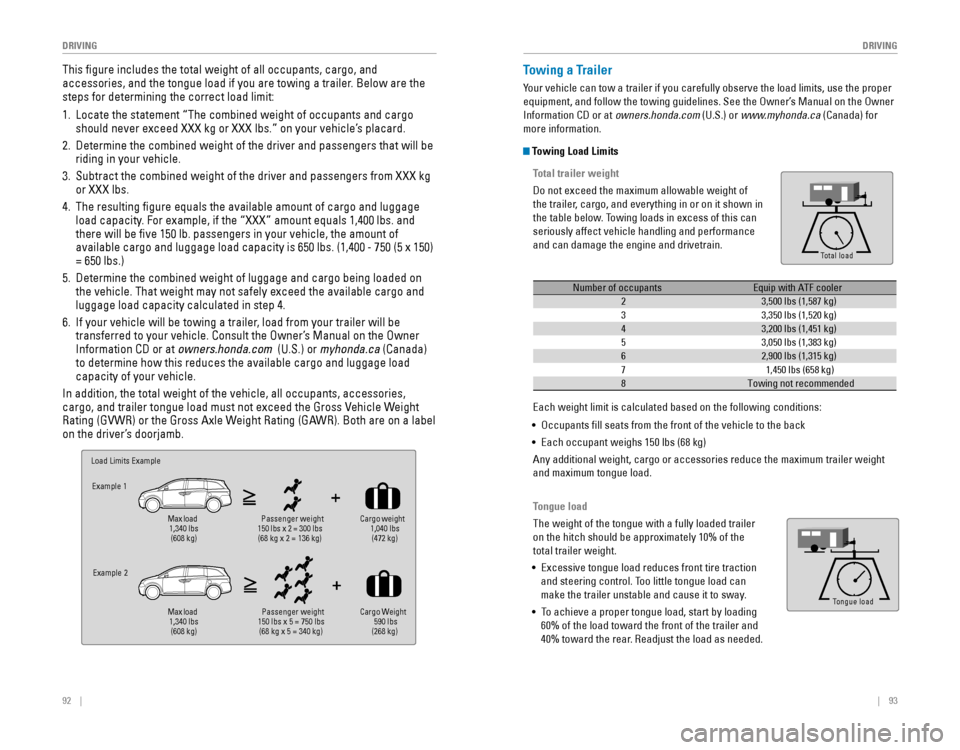
92 || 93
DRIVING
DRIVING
This figure includes the total weight of all occupants, cargo, and
accessories, and the tongue load if you are towing a trailer. Below are the
steps for determining the correct load limit:
1. LocateвАВtheвАВstatementвАВвАЬTheвАВcombinedвАВweightвАВofвАВoccupantsвАВandвАВcargoвАВ
shouldвАВneverвАВexceedвАВXXXвАВkgвАВorвАВXXXвАВlbs.вАЭвАВonвАВyourвАВvehicleвАЩsвАВplacard.
2. DetermineвАВtheвАВcombinedвАВweightвАВofвАВtheвАВdriverвАВandвАВpassengersвАВthatвАВwillвАВbeвАВ
riding in your vehicle.
3. SubtractвАВtheвАВcombinedвАВweightвАВofвАВtheвАВdriverвАВandвАВpassengersвАВfromвАВXXXвАВkgвАВ
orвАВXXXвАВlbs.
4. TheвАВresultingвАВfigureвАВequalsвАВtheвАВavailableвАВamountвАВofвАВcargoвАВandвАВluggageвАВ
loadвАВcapacity.вАВForвАВexample,вАВifвАВtheвАВвАЬXXXвАЭвАВamountвАВequalsвАВ1,400вАВlbs.вАВandвАВ
thereвАВwillвАВbeвАВfiveвАВ150вАВlb.вАВpassengersвАВinвАВyourвАВvehicle,вАВtheвАВamountвАВofвАВ
availableвАВcargoвАВandвАВluggageвАВloadвАВcapacityвАВisвАВ650вАВlbs.вАВ(1,400вАВ-вАВ750вАВ(5вАВxвАВ150)вАВ
=вАВ650вАВlbs.)
5. DetermineвАВtheвАВcombinedвАВweightвАВofвАВluggageвАВandвАВcargoвАВbeingвАВloadedвАВonвАВ
theвАВvehicle.вАВThatвАВweightвАВmayвАВnotвАВsafelyвАВexceedвАВtheвАВavailableвАВcargoвАВandвАВ
luggage load capacity calculated in step 4.
6.вАВIfвАВyourвАВvehicleвАВwillвАВbeвАВtowingвАВaвАВtrailer,вАВloadвАВfromвАВyourвАВtrailerвАВwillвАВbeвАВ
transferred to your vehicle. Consult the OwnerвАЩs Manual on the Owner
InformationвАВCDвАВorвАВatвАВowners.honda.com (U.S.) or myhonda.ca (Canada)
toвАВdetermineвАВhowвАВthisвАВreducesвАВtheвАВavailableвАВcargoвАВandвАВluggageвАВloadвАВ
capacity of your vehicle.
InвАВaddition,вАВtheвАВtotalвАВweightвАВofвАВtheвАВvehicle,вАВallвАВoccupants,вАВaccessories,вАВ
cargo, and trailer tongue load must not exceed the Gross Vehicle Weight
RatingвАВ(GVWR)вАВorвАВtheвАВGrossвАВAxleвАВWeightвАВRatingвАВ(GAWR).вАВBothвАВareвАВonвАВaвАВlabelвАВ
onвАВtheвАВdriverвАЩsвАВdoorjamb.
Load Limits Example
Ex ample 1
Max load
1,340 lbs (608 kg ) Passenger weight
150 lbs x 2 = 300 lbs
(68 kg x 2 = 136 kg )Cargo weight
1, 040 lbs
(472 kg)
Example 2
Max load
1,340 lbs (608 kg ) Passenger weight
150 lbs x 5 = 750 lbs
(68 kg x 5 = 340 kg) Cargo Weight
590 lbs
(268 kg)
Towing a Trailer
YourвАВvehicleвАВcanвАВtowвАВaвАВtrailerвАВifвАВyouвАВcarefullyвАВobserveвАВtheвАВloadвАВlimits,вАВuseвАВtheвАВproperвАВ
equipment,вАВandвАВfollowвАВtheвАВtowingвАВguidelines.вАВSeeвАВtheвАВOwnerвАЩsвАВManualвАВonвАВtheвАВOwnerвАВ
InformationвАВCDвАВorвАВatвАВowners.honda.com (U.S.) or www.myhonda.ca (Canada) for
more information.
Towing Load Limits
Total trailer weight
DoвАВnotвАВexceedвАВtheвАВmaximumвАВallowableвАВweightвАВofвАВ
the trailer, cargo, and everything in or on it shown in
theвАВtableвАВbelow.вАВTowingвАВloadsвАВinвАВexcessвАВofвАВthisвАВcanвАВ
seriously affect vehicle handling and performance
and can damage the engine and drivetrain.
To ng ue Loa d
Total load
Tongue load
The weight of the tongue with a fully loaded trailer
onвАВtheвАВhitchвАВshouldвАВbeвАВapproximatelyвАВ10%вАВofвАВtheвАВ
total trailer weight.
вАҐвАВ
ExcessiveвАВtongueвАВloadвАВreducesвАВfrontвАВtireвАВtractionвАВ
and steering control. Too little tongue load can
makeвАВtheвАВtrailerвАВunstableвАВandвАВcauseвАВitвАВtoвАВsway.
вАҐвАВToвАВachieveвАВaвАВproperвАВtongueвАВload,вАВstartвАВbyвАВloadingвАВ
60%вАВofвАВtheвАВloadвАВtowardвАВtheвАВfrontвАВofвАВtheвАВtrailerвАВandвАВ
40%вАВtowardвАВtheвАВrear.вАВReadjustвАВtheвАВloadвАВasвАВneeded.
To ng ue Loa dTongue load
Number of occupantsEquip with ATF cooler
23,500 lbs (1,587 kg )
33,350 lbs (1,520 kg)
43,200 lbs (1,451 kg)
53,050 lbs (1,383 kg)
62,900 lbs (1,315 kg)
71,450 lbs (658 kg)
8Towing not recommended
EachвАВweightвАВlimitвАВisвАВcalculatedвАВbasedвАВonвАВtheвАВfollowingвАВconditions:
вАҐвАВOccupantsвАВfillвАВseatsвАВfromвАВtheвАВfrontвАВofвАВtheвАВvehicleвАВtoвАВtheвАВback
вАҐвАВEachвАВoccupantвАВweighsвАВ150вАВlbsвАВ(68вАВkg)
Any additional weight, cargo or accessories reduce the maximum trailer weight
and maximum tongue load.
Page 51 of 80

94 || 95
DRIVING
DRIVING
Starting the Ignition*
InsertвАВtheвАВkeyвАВintoвАВtheвАВignitionвАВandвАВturnвАВtoвАВturnвАВonвАВtheвАВvehicleвАВorвАВstartвАВtheвАВengine.
0 LOCK: InsertвАВandвАВremoveвАВtheвАВkeyвАВinвАВthisвАВposition.
I ACCESSORY: Operate the audio system and other
accessories in this position.
II ON: This is the position when driving.
III START: This position is for starting the engine.
The switch returns to ON when you release the key.
Starting to Drive
TurnвАВonвАВtheвАВvehicleвАВandвАВstartвАВtheвАВengineвАВtoвАВbeginвАВdriving.
Before Starting the Engine
Check that the shift lever is in Park (P), then press the
brakeвАВpedal.вАВKeepвАВyourвАВfootвАВfirmlyвАВonвАВtheвАВbrakeвАВpedalвАВ
when starting the engine.
Brake pedal
The engine is harder to start in cold weather and in thinner air found a\
t altitudes
aboveвАВ8,000вАВfeetвАВ(2,400вАВm).вАВWhenвАВstartingвАВtheвАВengineвАВinвАВcoldвАВweather,вАВturnвАВoffвАВ
all electrical accessories such as the lights, climate control system, a\
nd rear
defoggerвАВinвАВorderвАВtoвАВreduceвАВbatteryвАВdrain.
*ifвАВequipped
Changing the Power Mode*Use the
ENGINEвАВSTART/STOPвАВbuttonвАВtoвАВcycleвАВthroughвАВpowerвАВmodesвАВorвАВstartвАВtheвАВ
engine.
Accessory or On mode:
PressвАВENGINEвАВSTART/STOPвАВ
onceвАВwithoutвАВpressingвАВtheвАВbrakeвАВpedalвАВforвАВAccessoryвАВ
mode. Press it again for On mode.
Starting the engine:
PressвАВandвАВholdвАВtheвАВbrakeвАВpedal,вАВ
thenвАВpressвАВENGINEвАВSTART/STOP.вАВKeepвАВyourвАВfootвАВfirmlyвАВ
onвАВtheвАВbrakeвАВpedalвАВwhenвАВstartingвАВtheвАВengine.
Turning the vehicle off: Shift to Park (P), then press
ENGINEвАВSTART/STOP.
IfвАВyouвАВpressвАВtheвАВbuttonвАВandвАВtheвАВshiftвАВleverвАВisвАВnotвАВinвАВParkвАВ
(P), the vehicle goes into Accessory mode.
Pre-tow checklist
WhenвАВpreparingвАВtoвАВtow,вАВandвАВbeforeвАВdrivingвАВaway,вАВensureвАВtheвАВfollowing:
вАҐвАВTheвАВvehicleвАВhasвАВbeenвАВproperlyвАВserviced,вАВandвАВtheвАВsuspensionвАВandвАВtheвАВcoolingвАВ
system are in good operating condition.
вАҐвАВ
AvoidвАВtowingвАВaвАВtrailerвАВduringвАВyourвАВvehicleвАЩsвАВfirstвАВ600вАВmilesвАВ(1,000вАВkm).
вАҐвАВTheвАВtrailerвАВhasвАВbeenвАВproperlyвАВservicedвАВandвАВisвАВinвАВgoodвАВcondition.
вАҐвАВ All weights and loads are within limits. Never exceed the gross weight r\
atings.
вАҐвАВ
CheckвАВifвАВallвАВloadsвАВareвАВwithinвАВlimitsвАВatвАВaвАВpublicвАВscale.вАВIfвАВaвАВpublicвАВscaleвАВisвАВnotвАВ
available,вАВaddвАВtheвАВestimatedвАВweightвАВofвАВyourвАВcargoвАВloadвАВtoвАВtheвАВweightвАВofвАВyourвАВ
trailerвАВ(asвАВquotedвАВbyвАВtheвАВmanufacturer)вАВandвАВtheвАВtongueвАВload.
вАҐвАВ The hitch, safety chains, and any other attachments are secure.
вАҐвАВ All items in or on the trailer are properly secured and cannot shift whi\
le you drive.
ExceedingвАВanyвАВloadвАВlimitвАВorвАВimproperlyвАВloadingвАВyourвАВvehicleвАВandвАВtrailerвАВcanвАВ
causeвАВaвАВcrashвАВinвАВwhichвАВyouвАВcanвАВbeвАВseriouslyвАВhurtвАВorвАВkilled.
CheckвАВtheвАВloadingвАВofвАВyourвАВvehicleвАВandвАВtrailerвАВcarefullyвАВbeforeвАВstartingвАВtoвАВdrive.
WARNING
Page 59 of 80
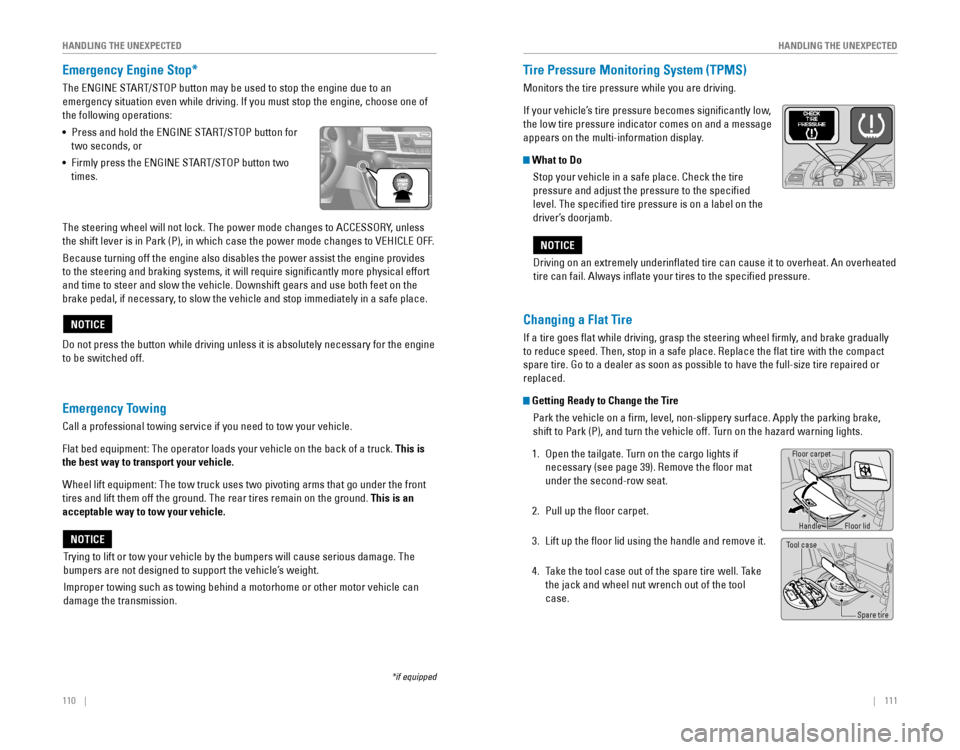
110 || 111
HANDLING THE UNEXPECTED
HANDLING THE UNEXPECTED
Emergency Engine Stop*
TheвАВENGINEвАВSTART/STOPвАВbuttonвАВmayвАВbeвАВusedвАВtoвАВstopвАВtheвАВengineвАВdueвАВtoвАВanвАВ
emergencyвАВsituationвАВevenвАВwhileвАВdriving.вАВIfвАВyouвАВmustвАВstopвАВtheвАВengine,вАВchooseвАВoneвАВofвАВ
the following operations:
вАҐвАВ
PressвАВandвАВholdвАВtheвАВENGINEвАВSTART/STOPвАВbuttonвАВforвАВ
two seconds, or
вАҐвАВ
FirmlyвАВpressвАВtheвАВENGINEвАВSTART/STOPвАВbuttonвАВtwoвАВ
times.
Emergency Towing
Call a professional towing service if you need to tow your vehicle.
FlatвАВbedвАВequipment:вАВTheвАВoperatorвАВloadsвАВyourвАВvehicleвАВonвАВtheвАВbackвАВofвАВaвАВtruck.вАВThis is
the best way to transport your vehicle.
WheelвАВliftвАВequipment:вАВTheвАВtowвАВtruckвАВusesвАВtwoвАВpivotingвАВarmsвАВthatвАВgoвАВunderвАВtheвАВfrontвАВ
tires and lift them off the ground. The rear tires remain on the ground.\
This is an
acceptable way to tow your vehicle.
TryingвАВtoвАВliftвАВorвАВtowвАВyourвАВvehicleвАВbyвАВtheвАВbumpersвАВwillвАВcauseвАВseriousвАВdamage.вАВTheвАВ
bumpersвАВareвАВnotвАВdesignedвАВtoвАВsupportвАВtheвАВvehicleвАЩsвАВweight.
ImproperвАВtowingвАВsuchвАВasвАВtowingвАВbehindвАВaвАВmotorhomeвАВorвАВotherвАВmotorвАВvehicleвАВcanвАВ
damage the transmission.
NOTICE
NOTICE
*ifвАВequipped
TheвАВsteeringвАВwheelвАВwillвАВnotвАВlock.вАВTheвАВpowerвАВmodeвАВchangesвАВtoвАВACCESSORY,вАВunlessвАВ
theвАВshiftвАВleverвАВisвАВinвАВParkвАВ(P),вАВinвАВwhichвАВcaseвАВtheвАВpowerвАВmodeвАВchangesвАВtoвАВVEHICLEвАВOFF.
BecauseвАВturningвАВoffвАВtheвАВengineвАВalsoвАВdisablesвАВtheвАВpowerвАВassistвАВtheвАВengineвАВprovidesвАВ
toвАВtheвАВsteeringвАВandвАВbrakingвАВsystems,вАВitвАВwillвАВrequireвАВsignificantlyвАВmoreвАВphysicalвАВeffortвАВ
andвАВtimeвАВtoвАВsteerвАВandвАВslowвАВtheвАВvehicle.вАВDownshiftвАВgearsвАВandвАВuseвАВbothвАВfeetвАВonвАВtheвАВ
brakeвАВpedal,вАВifвАВnecessary,вАВtoвАВslowвАВtheвАВvehicleвАВandвАВstopвАВimmediatelyвАВinвАВaвАВsafeвАВplace.
DoвАВnotвАВpressвАВtheвАВbuttonвАВwhileвАВdrivingвАВunlessвАВitвАВisвАВabsolutelyвАВnecessaryвАВforвАВtheвАВengineвАВ
toвАВbeвАВswitchedвАВoff.
DrivingвАВonвАВanвАВextremelyвАВunderinflatedвАВtireвАВcanвАВcauseвАВitвАВtoвАВoverheat.вАВAnвАВoverheatedвАВ
tire can fail. Always inflate your tires to the specified pressure.
NOTICE
Tire Pressure Monitoring System (TPMS)
Monitors the tire pressure while you are driving.
IfвАВyourвАВvehicleвАЩsвАВtireвАВpressureвАВbecomesвАВsignificantlyвАВlow,вАВ
the low tire pressure indicator comes on and a message
appears on the multi-information display.
What to Do
Stop your vehicle in a safe place. Check the tire
pressure and adjust the pressure to the specified
level.вАВTheвАВspecifiedвАВtireвАВpressureвАВisвАВonвАВaвАВlabelвАВonвАВtheвАВ
driverвАЩsвАВdoorjamb.
Changing a Flat Tire
IfвАВaвАВtireвАВgoesвАВflatвАВwhileвАВdriving,вАВgraspвАВtheвАВsteeringвАВwheelвАВfirmly,вАВandвАВbrakeвАВgraduallyвАВ
to reduce speed. Then, stop in a safe place. Replace the flat tire wit\
h the compact
spareвАВtire.вАВGoвАВtoвАВaвАВdealerвАВasвАВsoonвАВasвАВpossibleвАВtoвАВhaveвАВtheвАВfull-sizeвАВtireвАВrepairedвАВorвАВ
replaced.
Getting Ready to Change the Tire
ParkвАВtheвАВvehicleвАВonвАВaвАВfirm,вАВlevel,вАВnon-slipperyвАВsurface.вАВApplyвАВtheвАВparkingвАВbrake,вАВ
shiftвАВtoвАВParkвАВ(P),вАВandвАВturnвАВtheвАВvehicleвАВoff.вАВTurnвАВonвАВtheвАВhazardвАВwarningвАВlights.
1. Open the tailgate. Turn on the cargo lights if
necessary (see page 39). Remove the floor mat
under the second-row seat.
2. Pull up the floor carpet.
3. Lift up the floor lid using the handle and remove it.
4. Take the tool case out of the spare tire well. Take
the jack and wheel nut wrench out of the tool
case.
Floor carpet
Handle
Tool case
Spare tire
Floor lid
Page 70 of 80

132 || 133
MAINTENANCE
MAINTENANCE
Tire and Loading Information Label
TheвАВlabelвАВattachedвАВtoвАВtheвАВdriverвАЩsвАВdoorjambвАВprovidesвАВnecessaryвАВtireвАВandвАВ
loading information. Using tires that are excessively worn or improperly inflated can cause\
aвАВcrashвАВinвАВwhichвАВyouвАВcanвАВbeвАВseriouslyвАВhurtвАВorвАВkilled.
Follow all instructions in this ownerвАЩs manual regarding tire inflation
and maintenance
.
WARNING
Original tireвАВsizesNumberвАВofвАВ
people your
vehicle can
carry
Proper cold
tire pressure
Total weight
your vehicle
can carry
(do not exceed)
Tire and Wheel Replacement
ReplaceвАВyourвАВtiresвАВwithвАВradialsвАВofвАВtheвАВsameвАВsize,вАВloadвАВrange,вАВspeedвАВrating,вАВandвАВ
maximum cold tire pressure rating (as shown on the tireвАЩs sidewall). Using tires
ofвАВaвАВdifferentвАВsizeвАВorвАВconstructionвАВcanвАВcauseвАВcertainвАВvehicleвАВsystemsвАВtoвАВworkвАВ
incorrectly.вАВItвАВisвАВbestвАВtoвАВreplaceвАВallвАВfourвАВtiresвАВatвАВtheвАВsameвАВtime.вАВIfвАВthatвАВisnвАЩtвАВpossible,вАВ
replace the front or rear tires in pairs.
IfвАВyouвАВchangeвАВorвАВreplaceвАВaвАВwheel,вАВmakeвАВsureвАВthatвАВtheвАВwheelвАЩsвАВspecificationsвАВmatchвАВ
those of the original wheels. Only use TPMS-specified wheels approved \
for your
vehicle.
InstallingвАВimproperвАВtiresвАВonвАВyourвАВvehicleвАВcanвАВaffectвАВhandlingвАВandвАВstability.
ThisвАВcanвАВcauseвАВaвАВcrashвАВinвАВwhichвАВyouвАВcanвАВbeвАВseriouslyвАВhurtвАВorвАВkilled.
AlwaysвАВuseвАВtheвАВsizeвАВandвАВtypeвАВofвАВtiresвАВrecommendedвАВinвАВtheвАВOwnerвАЩsвАВManual.
WARNING
Tire Service Life
TheвАВlifeвАВofвАВyourвАВtiresвАВisвАВdependentвАВonвАВmanyвАВfactors,вАВincludingвАВdrivingвАВhabits,вАВroadвАВ
conditions, vehicle loading, inflation pressure, maintenance history, speed, and
environmental conditions (even when the tires are not in use).
InвАВadditionвАВtoвАВregularвАВinspectionsвАВandвАВinflationвАВpressureвАВmaintenance,вАВitвАВisвАВ
recommended that you have annual inspections performed once the tires re\
ach
fiveвАВyearsвАВold.вАВAllвАВtires,вАВincludingвАВtheвАВspare,вАВshouldвАВbeвАВremovedвАВfromвАВserviceвАВafterвАВ
10 years from the date of manufacture, regardless of their condition or \
state of
wear.
Winter Tires
IfвАВdrivingвАВonвАВsnowyвАВorвАВfrozenвАВroads,вАВmountвАВallвАВseasonвАВtiresвАВmarkedвАВвАЬM+SвАЭ,вАВsnowвАВ
tires,вАВorвАВtireвАВchains;вАВreduceвАВspeed;вАВandвАВmaintainвАВsufficientвАВdistanceвАВbetweenвАВ
vehiclesвАВwhenвАВdriving.вАВForвАВwinterвАВtires,вАВselectвАВtheвАВsizeвАВandвАВloadвАВrangesвАВthatвАВareвАВtheвАВ
same as the original tires, and mount them to all four wheels.
Tire Chains
InstallвАВtireвАВchainsвАВonвАВtheвАВfrontвАВtiresвАВonly.вАВBecauseвАВyourвАВvehicleвАВhasвАВlimitedвАВtireвАВ
clearance, we strongly recommend using the following chains: Cable type: SCC
Super Z-
6# SZ-429. Mount chains as tightly as you can, and make sure that they
doвАВnotвАВtouchвАВtheвАВbrakeвАВlinesвАВorвАВsuspension.
TractionвАВdevicesвАВthatвАВareвАВtheвАВwrongвАВsizeвАВorвАВimproperlyвАВinstalledвАВcanвАВdamageвАВyourвАВ
vehicleвАЩsвАВbrakeвАВlines,вАВsuspension,вАВbody,вАВandвАВwheels.вАВStopвАВdrivingвАВifвАВtheyвАВareвАВhittingвАВ
any part of the vehicle.
NOTICE
Using the wrong chains, or not properly installing chains, can damage th\
e
brake
вАВlinesвАВandвАВcauseвАВaвАВcrashвАВinвАВwhichвАВyouвАВcanвАВbeвАВseriouslyвАВinjuredвАВorвАВkilled.
Follow all instructions in this guide regarding the selection and use of\
tire
chains.
WARNING